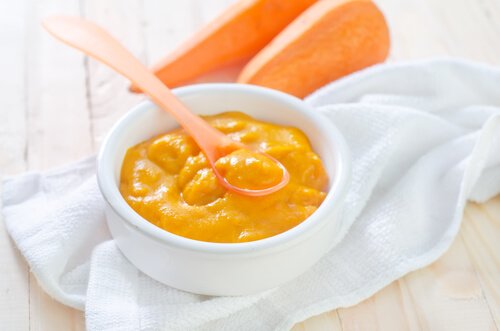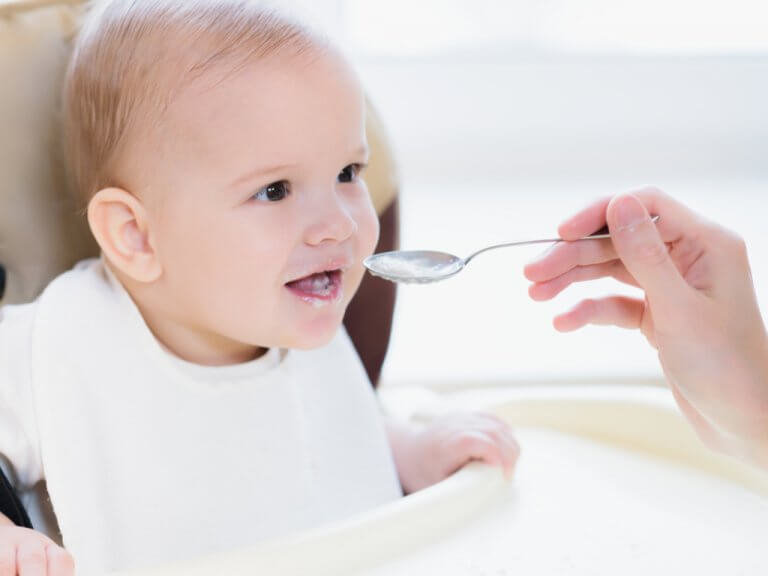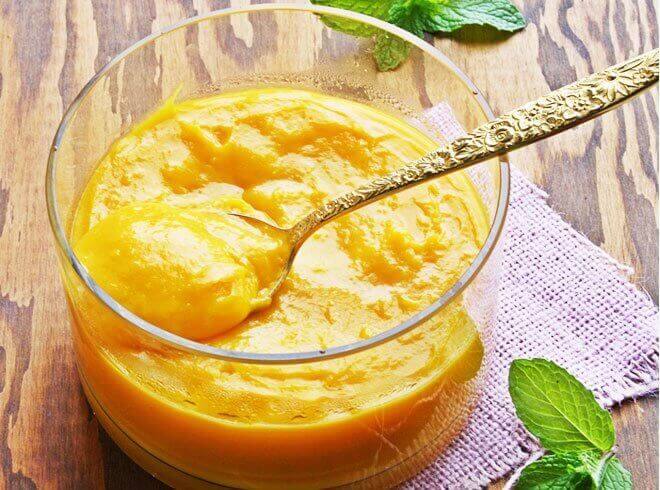The Benefits of Feeding Babies Fruit Puree

Breast milk is your baby’s main source of food and shouldn’t be substituted with anything. However, you can supplement your little one’s nutrition with fruit puree.
This provides various nutrients that contribute to your baby’s development.
Some of the benefits of fruit purees for babies
Fruits come in second in the food pyramid along with vegetables. That’s because they’re indispensable to good health. One of the best reasons to give fruit purees to babies is that they contain up to 95% water.
What’s more, they have vegetable fiber that helps regulate a baby’s bowel transit. A breastfed baby’s bowel habits vary greatly. They can even change as they grow into children. Although all fruits offer similar nutritional value, some can make a baby’s stools firmer or softer.
Fruits also contain vitamins, minerals, and simple carbohydrates without any fat. Your baby will have more energy if you include fruits in their diet. It will also get them used to eating healthy options instead of food that’s high in fat and artificial sugars.
What’s more, fruit purees provide antioxidants and micronutrients that prevent illnesses, such as obesity, constipation, cancer, and cardiovascular disease.
See also:
Foods That Contain Nitrosamines and are Potentially Carcinogenic
Including fruit purees in your baby’s diet

In fact, fruit purees should be a nutritional supplement to breast milk. As such, once your baby eats and tolerates purees well, slowly increase the amount you feed them.
Fruits that babies can eat according to their age
Even if your child can begin eating fruit purees at 6 months of age, some are more recommended than others due to the risk of allergies. That’s why you should introduce them to your baby gradually.
Doing so will enable you to assess your baby’s tolerance to each one. You should wait at least three days before introducing a new fruit puree. Below are the fruits you can give your little one according to their age.
At 6 months
Melon, grapes (without skins or seeds), plum, banana, pear, apple, kiwi, watermelon, pineapple, and mango.
After 6 months
Some doctors recommend introducing citrus fruit like oranges and tangerines after 6 months of age. However, others suggest waiting until 12 months of age because of possible allergic reactions.
At 12 months

The most recommended fruits for one-year-olds are peaches, apricots, and loquats among others.
After 12 months
Some pediatricians recommend including berries after 1 year of age. Still, others don’t recommend them until 15 months because of the risk of allergic reactions.
After 24 months
Dried fruit is recommended for children over 2 years of age.
Preparing fruit purees
- Make sure to pick out fruit that’s as ripe as possible. Avoid buying them unripe.
- Wash them thoroughly.
- Peel them, cut them into small pieces, and remove the seeds, pits, and pips.
- Cook the fruit by steaming or boiling it.
- Once cooked, process in a food processor until all lumps have been removed.
- Serve in a plate and let cool before feeding it to your baby.
- Avoid adding sugar; the mixture should have enough from the ripe fruit. It’s not good for your baby’s health to get them used to sweet food, as it could lead to future obesity.
- You can combine certain fruit so that your baby can try out different flavors.
Read up on:
Fruit purees for babies
Recipe 1: mango and apple puree

Ingredients
- 1 cup of mango, chopped
- 1 cup of apples, peeled and sliced
Preparation
- Clean the fruit and chop into small pieces.
- Add half a cup of water in a steamer.
- Cook the apple and mango for 2 minutes until soft.
- Put the mixture in a food processor or blend until smooth.
- Pour the mixture in a plate and let cool before serving to your baby.
Recipe 2: banana, pear, and apple puree
Ingredients
- ¼ of an apple
- Pear, as desired
- ¼ of a banana
- Half a glass of water
Preparation
- Peel the fruit and chop into small pieces.
- In a saucepan, add water and cook the pear and apple for 15 minutes. Next, remove the saucepan from heat.
- In a container, add the cooked apple and pear to the banana.
- Add the half a glass of water and mash the fruit until there aren’t any lumps left.
If your pediatrician gives you the green light, add half a cup of cereals to add more carbohydrates to your little one’s diet. Try these fruit purees with your baby and you’ll see an improvement in their nutrition.
All cited sources were thoroughly reviewed by our team to ensure their quality, reliability, currency, and validity. The bibliography of this article was considered reliable and of academic or scientific accuracy.
- Marion M. Hetherington, C. Schwartz, J. Madrelle, F. Croden, C. Nekitsing, C.M.J.L. Vereijken, H. Weenen,
A step-by-step introduction to vegetables at the beginning of complementary feeding. The effects of early and repeated exposure. Appetite, Volume 84, 2015, Pages 280-290, ISSN 0195-6663,
https://doi.org/10.1016/j.appet.2014.10.014. - Fisher, J. O., & Dwyer, J. T. (2016). Next Steps for Science and Policy on Promoting Vegetable Consumption among US Infants and Young Children. Advances in nutrition (Bethesda, Md.), 7(1), 261S-271S. doi:10.3945/an.115.009332
https://www.ncbi.nlm.nih.gov/pmc/articles/PMC4717881/ - Vegetable and Fruit Acceptance during Infancy: Impact of Ontogeny, Genetics, and Early Experiences (2016). Mennella JA, Reiter AR, Daniels LM.
https://www.ncbi.nlm.nih.gov/pubmed/26773029
This text is provided for informational purposes only and does not replace consultation with a professional. If in doubt, consult your specialist.








